For the first time in quite a while, Arizona Coyotes had a relatively uneventful trade deadline day.
They weren’t buyers. They weren’t sellers. They just…sat around and watched.
And that isn’t a bad thing – the ‘Yotes have been ravaged by injuries this year, and they knew they’d be getting multiple injured players back in the days following the Feb. 25 trade deadline.
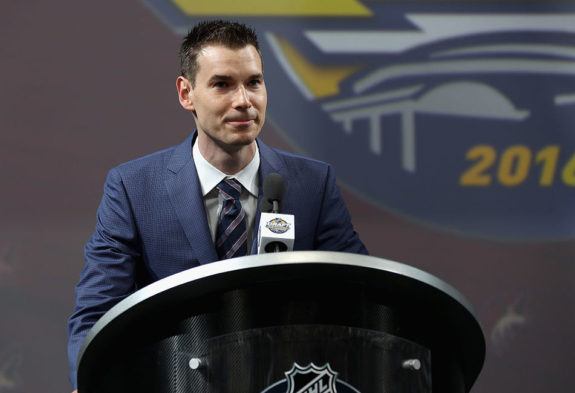
And indeed they have – Christian Dvorak and Jason Demers returned to the lineup on Feb. 26 and March 5, respectively, while Michael Grabner’s return is imminent as well. The club did lose Derek Stepan to injury in a 5-2 victory over the Vancouver Canucks on Feb. 28, but the team is, slowly but surely, getting healthier.
With that said, since there wasn’t much to write about at this year’s deadline, we at The Hockey Writers decided to take a look back at the Coyotes’ last several trade deadlines – who was moved, what did the franchise get back in return, and who won the trades?
2012: Coyotes Gear Up for Playoffs
We’ll begin our look back at the Coyotes’ trade deadline history with the 2011-12 season. At the end of January 2012, it appeared as if then-general manager Don Maloney would be a seller, as the then-Phoenix Coyotes sat with a record of 22-21-8 as the calendar flipped to February. The club was just three points off of the playoff pace, but sat at a distant 12th place in the Western Conference, with the Minnesota Wild, Colorado Avalanche, Dallas Stars, and Calgary Flames sitting between Phoenix and a postseason slot.
However, the Coyotes then embarked upon one of the best months in hockey history – they completely turned their season around by going 11-0-1 in the month of February. During that streak, Phoenix rapidly climbed up the standings in the Pacific and quickly emerged as buyers at the deadline.
With his team peaking at the right time, Maloney chose to tinker with his roster rather than make wholesale changes. As a result, he made just a single trade – Phoenix acquired veteran center Antoine Vermette from the Columbus Blue Jackets on Feb. 22 in exchange for AHL goaltender Curtis McElhinney, a 2012 second-round pick, and a 2013 fourth-round pick.
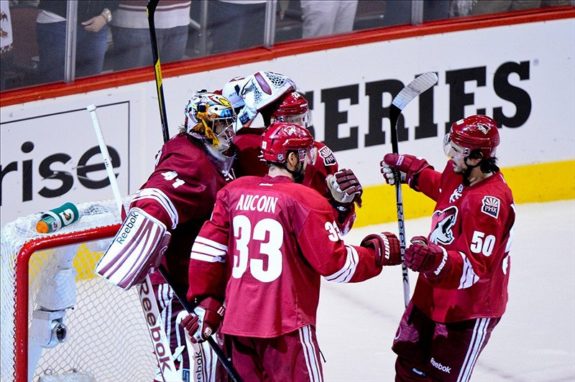
For the Coyotes, Vermette was a massive addition – the veteran racked up three goals and seven assists over the final 22 regular-season games to help Phoenix capture their first division title in franchise history, and he added another 10 points (five goals, five assists) in 16 postseason games. Vermette was especially good in Phoenix’s six-game victory over the Chicago Blackhawks in the Western Conference Quarterfinals, as he scored four times and added an assist to lead the Coyotes to their first-ever playoff series victory.
In total, Vermette spent parts of five seasons in the desert, racking up 70 goals and 79 assists in 291 career games for the Coyotes while also winning 56.5% of his faceoffs.
Not bad for a deadline-day acquisition.
As good as Vermette was in Phoenix, the Blue Jackets might have gotten the better end of the deal, though – they sent three draft picks (including both from the Vermette trade) to the Philadelphia Flyers on June 22, 2012 in exchange for a young, unproven goaltender named Sergei Bobrovsky.

Two Bobrovsky Vezina Trophies later, it’s safe to say that Columbus made the most of the assets they received for Vermette.
McElhinney was a good acquisition, too – he served as Bob’s backup for parts of four seasons and is still a reliable NHL goaltender at the age of 35.
Outcome: Win for both teams
Since Vermette was a key player in the Coyotes’ 2012 playoff run, and Columbus used the picks to acquire a franchise goaltender in Bobrovsky, both teams’ fortunes were significantly boosted as a result of this deadline deal – a rarity when it comes to trades in the NHL.
2013: Rearranging the Deck Chairs on the Titanic
After that magical run to the Western Conference Final in 2012, the Coyotes had their sights set on a return trip to the Stanley Cup playoffs in 2013.
However, Dave Tippett’s group got off to a slow start, which, combined with the lockout-shortened 48-game schedule, left them with little time to recover, and they found themselves on the outside of the playoff picture at deadline time. With his hands still tied by budgetary constraints caused by the still-ongoing league ownership, Maloney re-shuffled his roster in an attempt to spark his team to a solid finish to the season.
Sullivan Sent to New Jersey
The first of three minor moves of the April 3, 2013 trade deadline resulted in the Coyotes sending forward Steve Sullivan to the New Jersey Devils in exchange for a 2014 seventh-round pick. Sullivan was signed in an attempt to replace the production of Ray Whitney, who had signed in Dallas as a free agent over the summer of 2012. Sullivan never really found his groove with the Coyotes, though, and, outside of a hat trick in the third game of the season, struggled to find the scoresheet. He picked up the scoring pace in New Jersey, recording five points over the final nine games, but the Devils were unable to qualify for the Stanley Cup playoffs, and Sullivan retired following the season.
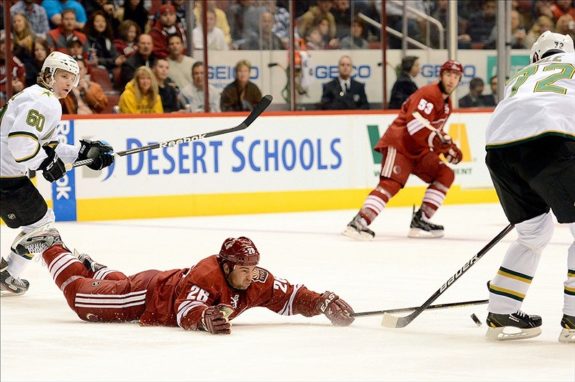
With that seventh-round selection, the Coyotes selected forward Jared Fiegl, who is now playing in the ECHL after a four-year college career at Cornell University.
Outcome: No winner
Coyotes Move On from Torres
On deadline day, the Coyotes also sent troubled forward Raffi Torres to the San Jose Sharks in exchange for a 2013 third-round pick. Torres, who was suspended for the final 13 contests of the 2012 Stanley Cup playoffs as well as the first eight games of the 2012-13 regular season after his hit on Marian Hossa, had five goals and seven assists in 28 games at the time of the deal.
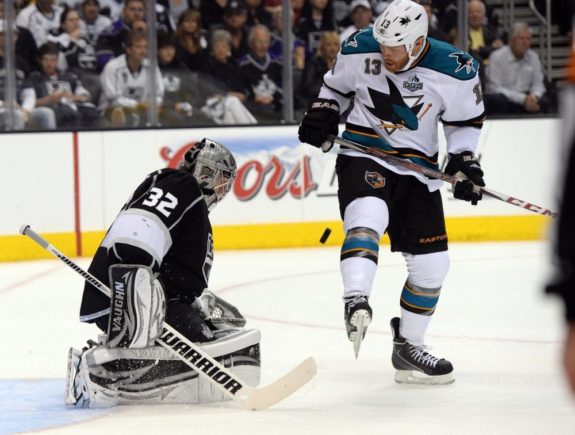
He played well for the Sharks down the stretch in 2013, recording six points in 11 games, but fizzled out in the playoffs as he scored just a single goal before being suspended for the remainder of the second round after a headshot on Jarret Stoll in Game 1 of the 2013 Western Conference Semifinals against the Los Angeles Kings, which San Jose lost in seven.
Torres went on to play just 12 more NHL games following the 2013 playoffs – a torn ACL and a 41-game suspension for another headshot effectively ended his career, and he retired in 2016.
With the 2013 third-round pick that the Coyotes acquired in the trade, they selected Yan-Pavel Laplante, who is currently in the Vancouver Canucks’ organization and has yet to reach the NHL.
Outcome: No winner
Arizona and Anaheim Swap Fourth-Liners
In their final move of deadline day, the Coyotes sent Matthew Lombardi to the Anaheim Ducks for Brandon McMillan. Lombardi was a key player for the 2009-10 Coyotes, who won 50 games, but he was well past his prime by 2013 – he had just four goals and four assists in 21 contests at the time of the trade, and was scoreless in seven games as a Duck, which was his final career NHL action.

McMillan also didn’t do much with his new team – he had a solid rookie season in 2010-11 in Anaheim, scoring 11 goals to go with 10 assists, but he managed to collect just three goals and six assists in 72 games in Arizona before being waived in 2015.
Outcome: No winner
None of these three trades resulted in either short-term or long-term benefits for the Coyotes – put simply, the 2013 trade deadline was a failure by Maloney and his staff.
2014: Erat and Dvorak Acquired
Following the disappointment of the 2012-13 season, the Coyotes bounced back in 2013-14 and got off to a good start, as they sat 10 games above .500 after an overtime victory over the Edmonton Oilers on New Year’s Eve.
However, Phoenix’s pace significantly slowed after the calendar flipped to January 2014 – the ‘Yotes accumulated a record of just 7-13-2 from Jan. 1 through March 2, and, with the trade deadline approaching on March 4, Maloney had to make a move to shake up his stagnating club.
On deadline day, Maloney indeed made two trades – one resulted in the departure of a respected veteran, while the other resulted in the addition of a future top-six center.
Coyotes and Capitals Swap Erat and Klesla
The first transaction sent long-time NHLer Rostislav Klesla, along with prospect Chris Brown and a 2015 fourth-round pick, to the Washington Capitals in exchange for forward Martin Erat and minor-leaguer John Mitchell.

Erat, who had infamously been acquired from the Nashville Predators at the 2013 deadline, never had a chance in Washington. Filip Forsberg, who headed to Nashville in the deal, immediately became a superstar with the Predators, while Erat scored two goals in 62 games as a Capital. Erat essentially was run out of town – the Capitals had to trade him. The veteran was better in Arizona, but played for some bad Coyotes teams and departed to Europe following the 2014-15 season after collecting 11 goals and 26 assists in 96 games in the desert.
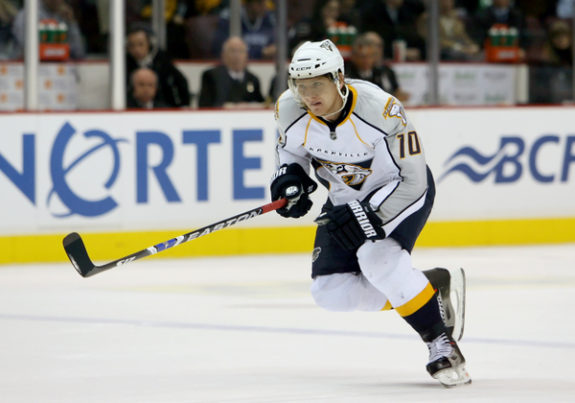
In trading Erat, Washington acquired Klesla, who had suffered through some injury issues stemming from a bad hit he received from Kings forward Jordan Nolan in the preseason, but they immediately flipped him to the Buffalo Sabres along with Michal Neuvirth in exchange for Jaroslav Halak and a third-round draft pick. Due to his injury issues, Klesla chose not to report to Buffalo, and ended his NHL career without playing another game.
Outcome: No winner
Neither team really came out with a long-term asset from this trade – we’ll chalk it up as a draw.
Coyotes Cut Losses on Rundblad
In their other trade at the 2014 deadline, the Coyotes elected to move on from defenseman prospect David Rundblad, sending him to Chicago along with minor leaguer Mathieu Brisebois in exchange for a second-round pick in the 2014 draft.
The No. 17 overall pick of the 2009 NHL Draft, Rundblad was acquired by the Coyotes in the trade that sent Kyle Turris to the Ottawa Senators on Dec. 17, 2011. In his age-19 season in 2010-11, Rundblad recorded 50 points in 55 games while playing in the Swedish Elite League (SEL). He was a rising prospect due to his offensive instincts, but he never was able to make the adjustment to the North American game. He struggled in his own end, and also struggled to put up points in the NHL as well.
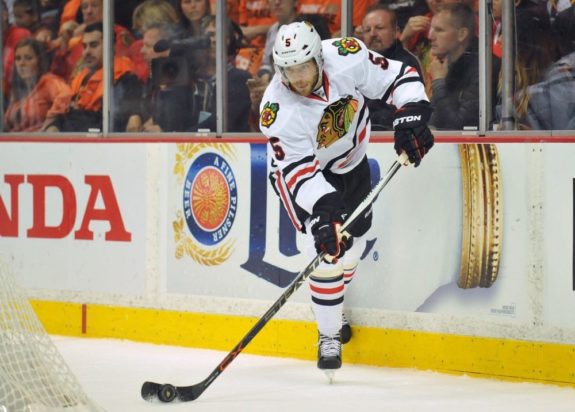
Rundblad was a press-box fixture during his tenure with the Coyotes, playing just 26 games across three seasons, and ultimately was moved to Chicago. He wasn’t much better in the Windy City, though, with 16 points across 71 total regular season and playoff games with the Blackhawks. Rundblad’s NHL career ended following the 2016 Stanley Cup playoffs – he’s played the last three seasons over in Europe.
With the draft pick the Coyotes acquired in this trade, they selected center Christian Dvorak at No. 58 overall. Dvorak missed the first five months of the 2018-19 season as he recovered from an injury, but he was good during his first two seasons as a pro – he posted back-to-back 15-goal campaigns to start his career, and appears to be a future top-nine center in the desert.

Outcome: Coyotes win the trade
In this trade, the Coyotes cut ties with a stagnating prospect while also picking up a draft pick which was used to select a future NHL center – not a bad haul for an offense-only defenseman.
2015: Coyotes Go All-In on Tanking
2014-15 was a season that Coyotes fans don’t want to remember.
With his team near the bottom of the standings, and with future superstars Connor McDavid and Jack Eichel up for grabs in the 2015 NHL Draft, Maloney elected to go all-in on tanking, rather than try to ice a competitive team down the stretch.
Coyotes Lose a Franchise Goaltender
Although it wasn’t a deadline deal, the fire sale began on Jan. 14, 2015, when the Coyotes traded Devan Dubnyk to the Minnesota Wild for a third-round pick in the 2015 draft. Since the trade, Dubnyk has been one of the NHL’s best goaltenders – he’s second among NHL netminders in wins (160) and shutouts (21), third in goals-against average (2.32), fourth in save percentage (.920), and leads the league in saves (7418), and games played (286).

With their third-round selection, the Coyotes drafted forward Brendan Warren out of the USA Hockey National Team Development Program, who has since been traded (along with 2018 fifth-rounder) to the Flyers for forward Nick Cousins and goaltending prospect Merrick Madsen.
Cousins has played 137 games for the Coyotes over the last two seasons, scoring 18 goals to go with 25 assists. He’s been a solid bottom-six player for head coach Rick Tocchet, and has emerged as a shootout specialist as well – he’s 4-for-7 as a Coyote in the skills contest. Madsen, a 6-foot-5 goaltender out of Harvard, has split time between the AHL and ECHL this year, and has put up pretty pedestrian numbers in both leagues. However, he’s still just 23 years old and is a first-year pro – he could develop into a solid option for the franchise as either an AHL starter or an NHL backup.
Outcome: Wild win the trade
Cousins has been good for the Coyotes since being acquired, and Madsen appears to have some potential, but Dubnyk could have been the reliable, productive franchise goaltender that Arizona has searched for since Mike Smith’s miraculous 2011-12 campaign. Instead, another one of his backups was shipped out of town due to Smith’s huge, untradeable contract, and the Coyotes were fleeced in this one as a result.
Vermette Chases (And Wins) the Cup
After being a deadline acquisition in 2012 for the Coyotes, Antoine Vermette was a deadline trade piece for the franchise in 2015.
On Feb. 28, the veteran centerman, who was a pending free agent, was shipped off to the Chicago Blackhawks in exchange for defenseman Klas Dahlbeck and Chicago’s 2015 first-round pick. Vermette played just 39 combined regular season and playoff games in Chicago, but he made the most of them – he scored the double-overtime game-winner in Game 4 of the Western Conference Final against the Anaheim Ducks, then scored the game-winner in both Game 1 and Game 5 of the Stanley Cup Final, which Chicago won in six games.
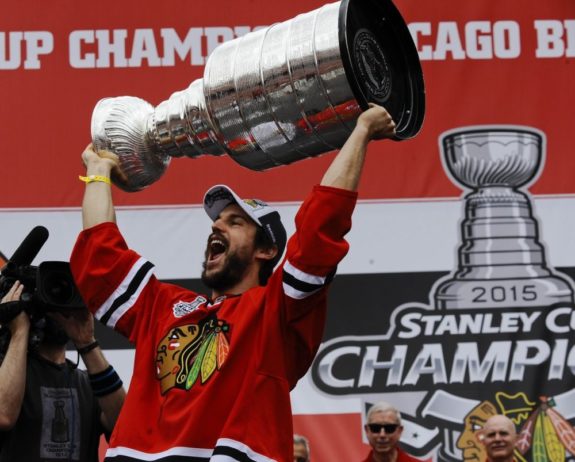
Vermette wasn’t gone long, though – he returned to Arizona as a free agent over the following offseason.
Dahlbeck had some nice moments in a Coyotes sweater in 2015 and 2016, but he failed to solidify himself as an NHLer and is now in the KHL after spending the 2016-17 and 2017-18 seasons in the Carolina Hurricanes organization.
With their first-round pick, the Coyotes selected forward Nick Merkley from the WHL’s Kelowna Rockets. Merkley has been solid in the AHL during his two years as a pro, and even played one NHL game in 2017-18, but he’s had some struggles with injuries, which have limited him to just 68 competitive games during his professional career. He might not make the team this year, but keep an eye on him in 2019-20.
Outcome: Blackhawks win the trade
They say deadline moves are only scrutinized or second-guessed if teams fail to win the Stanley Cup.
Well, the Blackhawks gave up a first-round pick for four months of Vermette’s services, but they won the 2015 Stanley Cup.
Give them the win in this trade, too.
The Duclair/Yandle Trade
Arguably the biggest trade of the 2015 deadline was the March 1 deal that sent defenseman Keith Yandle and AHLer Chris Summers, along with a 2016 fourth-rounder, to the New York Rangers in exchange for forward Anthony Duclair, defenseman John Moore, a 2015 second-round pick, and a 2016 first-round selection.
Yandle, who was drafted and developed by the Coyotes and had played his first 495 career NHL games with the franchise, was a bit of a polarizing figure in Arizona. His penchant for putting up points, along with his apparent carelessness with the puck at times, caused fans to form a love/hate relationship with the All-Star defenseman.
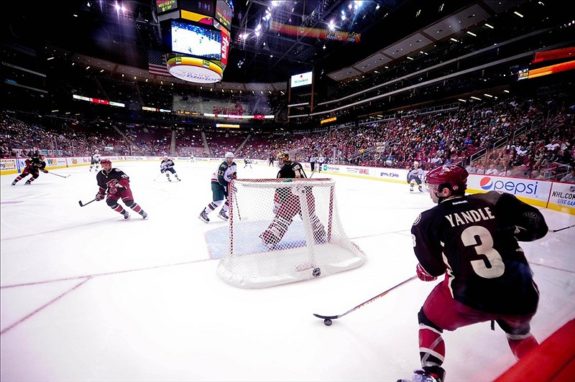
At any rate, Yandle was highly-regarded at the time of the trade for his offensive abilities from the blue line, and, while he came at a high price, he indeed put up a ton of points in New York (58 in 103 regular-season games and 12 more in 24 playoff contests). However, the Blueshirts were bounced in Game 7 of the Eastern Conference Final by the Tampa Bay Lightning in 2015, and they suffered a five-game first-round defeat at the hands of the eventual-champion Pittsburgh Penguins in 2016. Yandle, a pending free agent, was then moved to the Florida Panthers on June 20, 2016, and he signed a long-term extension to remain in South Florida shortly thereafter.
Summers is no longer with the Rangers organization after spending most of his time with the AHL’s Hartford Wolf Pack, and New York used the 2016 fourth-round pick to select defenseman Tarmo Reunanen, who is playing professionally in Finland.
Now, let’s get to Arizona’s haul from this trade – Duclair, Moore, the 2015 second, and the 2016 first.
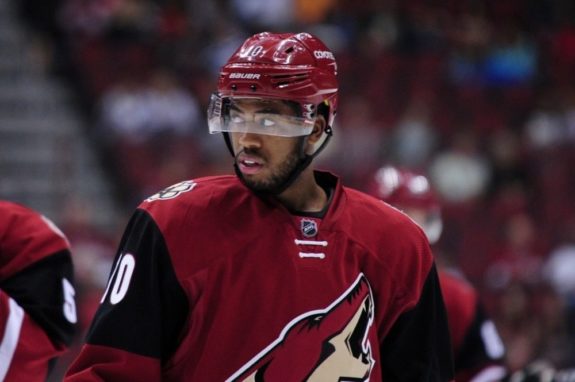
Obviously, Anthony Duclair was the big prize that headed the other way in the deal, but things didn’t really work out for him in Arizona. Following a stellar 20-goal, 44-point rookie season in 2016-17 which had fans excited for what the future would hold, Duclair scored just 14 goals and 16 assists over his next 91 games with the franchise, and he was sent to the Blackhawks on Jan. 10, 2018 in the trade that brought Richard Panik to Arizona. “The Duke” is now with the Ottawa Senators – his fourth team in two seasons – and his NHL job security is in serious jeopardy if he can’t rediscover the scoring touch he showed as a rookie.
Moore, the other NHL asset which went to Arizona in the trade, played just 19 games with the franchise before leaving as a free agent.
The 2015 second-round pick was then traded to the Tampa Bay Lightning on draft day, and the Coyotes selected Adin Hill and Jens Looke with the picks they acquired from that deal. Looke is in the midst of his second AHL season, but Hill has already made an impact in the NHL – he won seven games this season and held down the fort for a short time when Antti Raanta went down.
The Coyotes also traded the 2016 first-round pick – it was used (along with another pick from another trade – more on this later) on draft day to trade up with the Detroit Red Wings and select defenseman Jakob Chychrun at No. 16 overall. The Coyotes also had to take on Pavel Datsyuk’s contract in the transaction, but it was a small price to pay to draft a future top-four defenseman in Chychrun.
Outcome: Coyotes win the trade
This trade looked like a win for both teams early on, as both Yandle and Duclair got off to good starts with their new clubs, but now, four years later, neither player is on the team which traded for them.
However, the Coyotes have made the most of the other assets they received, while New York has not.
We’ll give Arizona the slight edge here.
Michalek Sent to St. Louis
The final deadline deal of the 2014-15 season came on March 2, when defenseman Zbynek Michalek was sent to the St. Louis Blues in exchange for forward prospect Maxim Letunov.
Michalek was brought in to shore up the Blues’ defense corps, and, while he did help St. Louis get to the playoffs, he could not help them win their first-round series, as the Blues lost to the Minnesota Wild in six games. After his short tenure as a Blue, Michalek returned to the Coyotes over the offseason, meaning Arizona acquired Letunov for practically nothing.
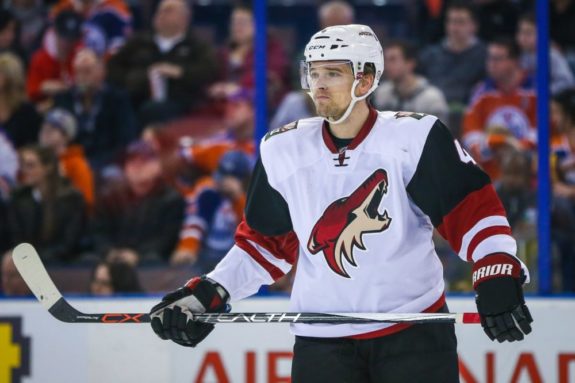
However, Letunov did not last long in the Coyotes organization – he was traded to the San Jose Sharks on June 20, 2016, for a 2016 fourth-round pick and a 2017 third-round selection.
The 2016 fourth-rounder was retroactively sent to Philadelphia as soon as it was acquired – a conditional fourth-round pick was included as part of the June 27, 2015 trade that brought Nicklas Grossmann and the contract of Chris Pronger to Arizona, with Sam Gagner going the other way. As part of the trade, Arizona would be required to send a 2016 fourth-round pick to the Flyers if they acquired another selection in that round of the draft, which they did in the Letunov trade.
The 2017 third-rounder was used to select forward MacKenzie Entwistle, who, along with Marcus Kruger, Jordan Maletta, Andrew Campbell, and a 2019 fifth-rounder, was part of the blockbuster which brought Jordan Oesterle, Vinnie Hinostroza, and the contract of Marian Hossa to Arizona.
Outcome: Coyotes win the trade
The Coyotes received an asset by trading Michalek, then re-signed him over the following offseason.
They say there’s no such thing as a free lunch, but this is as close as it gets in the NHL.
2016: Boedker Shipped Out
The 2016 trade deadline was a relatively quiet one for the Coyotes. Multiple deals went down on the Feb. 29 deadline, but only one had NHL implications, as long-time Coyote Mikkel Boedker was dealt to the Colorado Avalanche in return for Alex Tanguay, Kyle Wood, and the rights to Conner Bleackley.
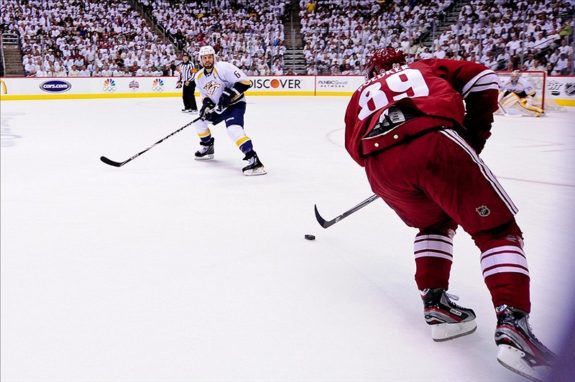
Boedker, who was a homegrown talent, had a good career in the desert – he played in 445 games as a Coyote, collecting 80 goals and 133 assists in the process. However, he never seemed to reach his potential – he possesses outstanding speed and skill, but has never been able to utilize it consistently, as he’s failed to score 20 goals in any of his 11 NHL campaigns. Boedker was a pending free agent following the 2015-16 season, and the Coyotes wisely elected to trade him rather than sign him to a long-term extension, which he received (four years at $4 million per year) from the San Jose Sharks.
Tanguay had some nice moments with Arizona after being traded – he posted 13 points in 18 games in a Coyotes sweater and developed some chemistry with fellow Quebecers Antoine Vermette and Anthony Duclair down the stretch. However, he was not brought back by the franchise following the season despite his solid numbers, and the veteran announced his retirement a few months later.
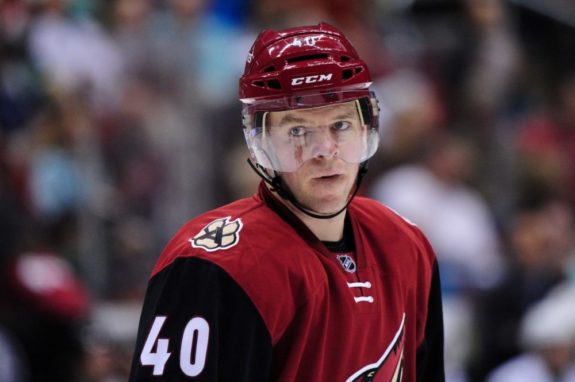
Wood initially looked like he might be the best asset of this trade, as he was an AHL All-Star during his first year as a pro in 2016-17, but his development began to stagnate shortly thereafter and he was traded to the San Jose Sharks on June 14, 2018, where he remains an AHL player.
The final piece of the trade, Bleackley, was never going to be a Coyote – he had suffered a myriad of injuries in his post-draft years and was unsigned at the time of the transaction. As a result, the Coyotes elected to receive a compensatory draft pick rather than sign Bleackley to an entry-level contract, which ended up being at No. 53 overall in 2016. This pick (along with the No. 20 pick acquired in the earlier Yandle/Duclair trade) was used to acquire Detroit’s first-round pick, which was used to select Chychrun.
Outcome: Coyotes win the trade
Since Boedker failed to help the Avalanche reach the 2016 postseason, and Arizona used one of the acquired assets to trade up and draft Chychrun, we’ll give the Coyotes the edge here.
2017: Hanzal, Stone and White on the Move
Under new general manager John Chayka, who had been promoted following the firing of Maloney on April 11, 2016, the Coyotes were sellers at the 2017 trade deadline, and they were significantly more active than in 2016.
Stone Returns to Calgary
The first trading chip to be moved out of Arizona was defenseman Michael Stone, who was sent to the Calgary Flames on Feb. 20, 2017, in exchange for a 2017 third-round pick and a 2018 conditional fifth-rounder, which was converted when Stone signed a contract extension in Calgary on June 30.
Stone had his breakout year in 2015-16 with the Coyotes, as he racked up 36 points in 75 games and emerged as a reliable power-play contributor. However, his season ended prematurely on March 26 of that year, when he suffered a major knee injury late in a game against the Philadelphia Flyers. Stone recovered quickly and returned to Arizona’s lineup in 2016-17 after missing just the first three games of the new season, but it quickly became clear that he wasn’t the same player he was before the injury.
As a result, Stone rapidly became expendable, especially after the offseason additions of Chychrun and Alex Goligoski, and he emerged as a contender to be traded at the deadline. The right-handed defender was indeed sent to the Flames, who were in playoff contention under first-year head coach Glen Gulutzan. Stone, who also played his junior hockey at the Saddledome with the Calgary Hitmen, played the final 19 games for Flames that year, recording two goals and four assists to go with a plus-five rating. He indeed helped Calgary earn the West’s No. 7 seed, but the Flames were swept out of the playoffs by their kryptonite, the Anaheim Ducks.
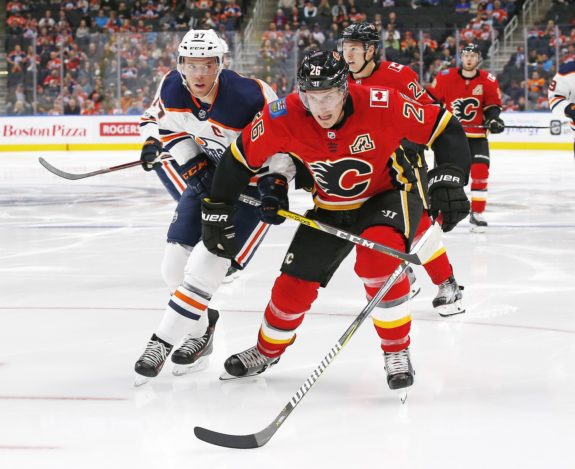
The Coyotes’ haul for Stone consisted of two draft picks. The first of which, the 2017 third-rounder, was used by Chayka as a trade chip on draft day, as he sent the pick to the Oilers for their own third-round selection, as well as their fifth-round pick later in the draft. Chayka used these selections on defensemen Cameron Crotty and Michael Karow, who both are in the midst of their sophomore seasons of college hockey. The 2018 fifth-rounder provided a more immediate benefit – Chayka sent that selection to the New Jersey Devils to acquire Scott Wedgewood in an attempt to shore up the Coyotes’ goaltending depth at the beginning of the 2018 campaign. Wedgewood was unable to carry the load for Arizona, and he was sent to Los Angeles in the trade that brought Darcy Kuemper to Arizona (more on this later).
Outcome: Arizona wins the trade
Stone has struggled with injuries and hasn’t done much in Calgary since being moved, while Kuemper has made a huge impact in Arizona after eventually ending up in Arizona as part of this trade tree.
We’ll give the win to the Coyotes here.
Coyotes Fleece Minnesota at Deadline
After the Stone trade, six days passed before the Coyotes’ other big trade piece, Martin Hanzal, was moved to the Minnesota Wild on Feb. 26 along with Ryan White and a 2017 fourth-round pick. In return, Arizona received Minnesota’s 2017 first-round pick, their 2018 second-round selection, a 2019 fourth-rounder, and prospect Grayson Downing.
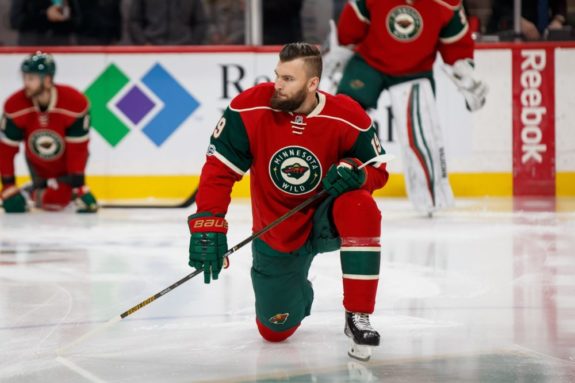
At the time of the trade, the Wild were the West’s best team, with a record of 39-14-6. They won their first two games with Hanzal and White in the lineup, but then finished the season on an 8-11-2 slide before meeting the St. Louis Blues in the first round of the playoffs, where they were soundly defeated in just five games. Hanzal and White then departed following the season, leaving the Wild with nothing to show for the trade. The Coyotes, on the other hand, have made the most of their return from the transaction. The extra 2017 first-round pick they acquired from Minnesota allowed the franchise to trade its own first-rounder (at No. 7 overall), along with defenseman prospect Tony DeAngelo to the New York Rangers in the deal that brought Antti Raanta and Derek Stepan to Arizona.
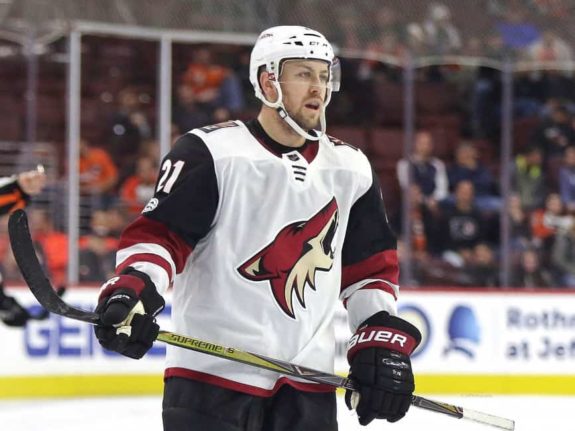
With Minnesota’s first-round selection, the Coyotes drafted defenseman Pierre-Olivier Joseph from the QMJHL’s Charlottetown Islanders. Joseph has been a point machine in the QMJHL since being drafted – he’s collected 22 goals to go with 69 assists in his last 120 contests. With good size at 6-foot-2 and good offensive instincts, Joseph has NHL potential.
With the 2018 second-rounder, Arizona drafted defenseman Kevin Bahl from the OHL’s Ottawa 67’s. Bahl, a 6-foot-6 defender, has four goals to go with 27 assists in “The O” this season, and he leads all defensemen in the league with his plus-46 plus/minus rating. Skating is always a concern with big defensemen, but Bahl will be given every chance to make the roster in Arizona, especially as the NHL club’s defense corps continues to get older in the coming years.

The final asset from the trade, the 2019 fourth-rounder, was sent (along with goaltender Michael Leighton) to the Pittsburgh Penguins on Dec. 19, 2017, in exchange for a 2019 sixth-rounder, prospect Sean Maguire, and forward Josh Archibald, who has been a good depth player for the organization since being acquired.
Outcome: Coyotes win the trade
Since Minnesota suffered a quick first-round defeat after bringing in Hanzal and White at the deadline, and the Coyotes have used the assets to acquire three current NHL roster players (and two future NHLers), this one was a huge victory for Chayka and his staff.
2018: Coyotes Get Kuemper
The 2018 trade deadline was a relatively quiet one for the Coyotes, as they made just one transaction – they sent forward Tobias Rieder and goaltender Scott Wedgewood to the Los Angeles Kings in exchange for goaltender Darcy Kuemper on Feb. 21, 2018.
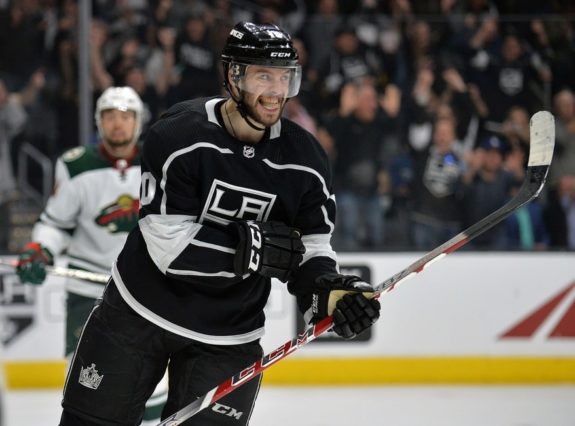
At the time, the trade looked like a win for the Coyotes, and that has held up over a year later. Rieder, a pending unrestricted free agent, was acquired by Los Angeles to bolster their offense for the stretch run and Stanley Cup playoffs, and, while the Kings did qualify for the postseason, they were swept by the Vegas Golden Knights in four games. Rieder recorded just four goals and two assists in 20 regular season games for John Stevens’ squad, and was held off the scoresheet in four playoff contests. Rieder then moved on from Los Angeles on July 1, signing a one-year deal with the Edmonton Oilers.
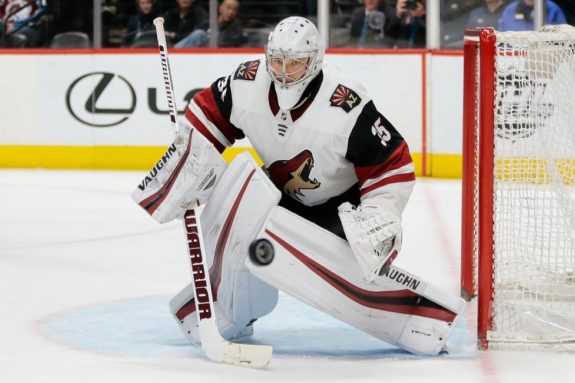
Wedgewood, who is now with the Buffalo Sabres organization, never played a game for the Kings – he instead was assigned to the Ontario Reign of the AHL, with Jack Campbell stepping up into LA’s backup role behind starter Jonathan Quick. Kuemper struggled in 10 games with the Coyotes last season after being acquired, but, after having an offseason to get used to his new city and team, he’s excelled on the ice. Kuemper’s been the starter for most of the season after Antti Raanta went down with an injury in November, and he’s kept the Coyotes in the playoff hunt with a 20-15-5 record, a .918 SV%, and a 2.55 GAA, along with two shutouts.
Outcome: Coyotes win the trade
Since the Kings do not have any assets left from this trade, and the Coyotes have themselves a solid goaltender in Kuemper, this was a clear win by Chayka and his staff.
Chayka Stands Pat in 2019
With the Coyotes hanging around the playoff cutoff line, and with multiple injured players (Jason Demers, Michael Grabner, and Christian Dvorak) on the mend, Chayka chose to stand pat at the Feb. 25, 2019 deadline. He traded Jordan Weal to the Montreal Canadiens for Michael Chaput, but the trade was only made to clear a roster spot for the returning Dvorak. Not much needed to be done – the Coyotes were rolling, and had “rentals” of their own returning to the lineup.
Overall, the Coyotes have done well at the trade deadline in recent years. Sure, there have been a few duds (namely, 2013 and 2014), but, for the most part, the franchise has done a good job of maximizing the return for their trade chips. The 2019 trade deadline was a quiet one for general manager John Chayka, but, when next year’s trade market opens up, expect him to once again be aggressive in acquiring assets for the future.